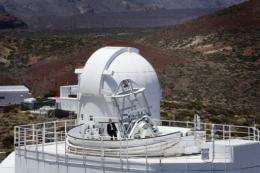A man stands atop the German Solar Telescope GREGOR on the Spanish Canary island of Tenerife. A powerful solar telescope billed as the largest in Europe opened Monday on Spain's Canary Islands which scientists say will allow them to study the sun in unprecedented detail.
A powerful solar telescope billed as the largest in Europe opened Monday on Spain's Canary Islands which scientists say will allow them to study the sun in unprecedented detail.
With a mirror diametre of 1.5 metres (4.9 feet), the Gregor telescope will be able to show structures on the sun on scales as small as 70 kilometres (43.5 miles), the Astrophysical Institute of the Canary Islands said in a statement.
The telescope was built on the island of Tenerife at a cost of 12.85 million euros ($16.4 million) by a German consortium led by the Kiepenheuer Institute for Solar Physics in Freiburg which covered the majority of the expense.
"Its advanced technology will allow the scientific community -- Spanish, German and international -- to study the sun in an unprecedented level of detail," the statement said.
In addition to the large diametre of its mirror, the telescope features a retractable roof that prevents air turbulence in its optical path which allows it to deliver "images of a sharpness that up until now no terrestrial solar telescope has ever obtained."
The solar telescope is the largest in Europe and the third largest in the world, the institute said.
"Gregor was built mainly to study physical processes on the surface of the sun," said Oskar von der Luhe, the director of the Kiepenheuer Institute.
"In these layers we see how energy from its interior emerges and then is launched into space, and on some occasions, reaches the Earth," he added.
Named after 17th century Scottish mathematician and astronomer James Gregory, the telescope will be used at night to observe stars.
(c) 2012 AFP





















